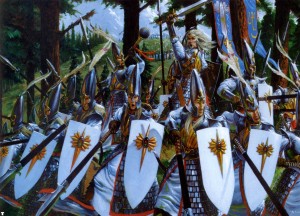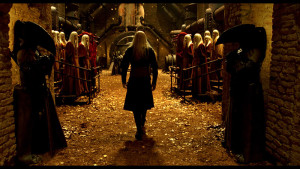[This is the fifth post in a series dissecting the campaign ‘bible’ document I drafted while planning my AD&D 1e campaign. See here for an introduction to this series of posts. Technically, this installment should have dealt with the dwarven settlements on the island of Curasaur, but that is a more involved post given how the campaign has panned out so far and needs more time to draft.]
The First Problem with Elves, or “How Elrond Destroys History”
As described in the first edition core books, elves are problematic for any campaign setting intended to have a historical background that is meaningful yet not overly deterministic. The core of this issue is made clear on page 13 of the DMG: a venerable high elf — the presumed standard elf as per page 16 of the PHB — with a bit of luck and healthy living can hope to see their 1500 (if not 1600) birthday. In other words, the default AD&D setting has NPCs running around who in our world could have been personal friends with King Hygelac of the Geats (d. 516 C.E.) long before his story was co-opted into Beowulf. Consider for just a moment how different our conception of history would be if eye-witnesses to fifteen or sixteen centuries were wandering around and able to answer our questions. Yes, yes … I know that elves are supposed to be aloof and insular with no concerns about the world outside their society because Tolkien said so, but aloof is not the same as ignorant. That’s not even getting into the question of why a race that must put up with the world for longer than anyone else would think it’s a good idea to sit back and let the chips fall where they may rather than actively seek to shape their environment.
In any event, it all boils down to the fact that by-the-book elves undermine our standard view of historical knowledge in which its possible to have competing narratives of events that only happened a couple hundred years ago and to be completely ignorant of basic information about life a thousand years ago. You want an ancient civilization that no one knows much about in your standard setting? It’s going to have to be many thousands of years since its fall or else your average elderly elf may have visited that civilization’s capital city in its heyday. For reasons that will become clearer as this series and the play reports to follow progress, this was not a satisfactory solution for me. Instead, I decided to peg the lifespan of high elves to the standard given for mountain dwarves, effectively chopping off a thousand years. That made it possible to have ancient history that was mysterious and yet not so ancient as to be meaningless. Now it was time to tackle the other Tolkien-inspired clichés.
The Second Problem with Elves, or “Can You Have Non-Apathetic Elves that Don’t Rule the World?”
AD&D elves have a lot in common with Tolkien elves and Tolkien elves are worn out from their endless struggles against evil. In the original context of The Silmarillion or Lord of the Rings, that makes perfect sense. Outside of that context, though, it is hard to justify the kind of apathy among elves that would lead to the human-centric world that is also an assumption of the AD&D rules. This is not really a great insight on my part — others have wrestled with this same issue and one common solution has been to depict elves as victims of the human race’s expansionist tendencies who now hang on the edges of society as a marginalized people (e.g., Dragon Age, The Witcher series). That’s not bad, but that solution is becoming a bit of a cliché in its own right and my solution was to assume that act of marginalization was in the Curabel setting’s past and to consider what a elven society that has come back from the brink of extinction at the hands of mankind would look like once the counter-revolution is over. In other words, what kind of society would those Bolshevik elves create once freed from the Tsarist oppression of a human empire.
The Northern Island: Elves as Political Exiles
The description of the elven homeland in Curabel is a succinct two paragaphs, but there my intention was to pack a lot of implied background into these lines:
Curanost
The “North Island,” originally designated a penal colony for elves, has now been adopted as the elven homeland in Curabel and rechristened Valhal (Wood home).[1] These elves are friendly with humans – especially descendants of the imperial colonists – but human forgetfulness of history sometimes strains that relationship. This isle supplies the great trees for ship masts throughout Curabel.Vallande is the only city-state on Curanost – indeed, it is the only city of any size at all on the island. The city is notable for its lumber yards, sizable harbor, and plentiful parks.
[1] Note: Curanost technically refers to several of the northernmost islands (hence the plural construction used). However, in common usage, the name refers to the largest of the north islands.
Ostensibly, these paragraphs just tell players that the elves have taken the northernmost islands as their homeland and that they are generally friendly with humans. For the purposes of the campaign as played to date, that has been sufficient because my players seem much more partial to dwarves and their society/history. However, here are some of the hooks built into this description:
- Elves are political exiles and Curabel is their penal colony. The unstated assumption here is that they were designated enemies of the human empire, hence their special closeness to the descendants of the imperial colonists who led the rebellion against that empire. This has come up in the ongoing campaign in the person of an Elven sage named Aldus Runnelbrook. Aldus, who now runs a bookstore, was a leader in the rebellion and responsible for organizing the underground presses turning out anti-imperial propaganda.
- The Elves have a strained relationship at times with humans because that other race is forgetful. In other words, elves remember the revolutionary struggle vividly and oscillate between pitying and resenting the ability of their human allies to forget the danger posed by the bourgeoisie — sorry, I mean empire. Aldus, for instance, tends to be more understanding and councils his human descendants (from a second marriage to a human) to be watchful but merciful; his oldest son (from a first marriage to another elf) still feels the loss of his mother shortly after the rebellion strongly and is more warlike, recommending a policy of preemptive violence.
- Their island is heavily forested, inspiring their renaming of the island and explaining the ongoing trade relationship with the sea-faring human city-states. This fits with the typical view of elves as a people more in touch with nature (even if the existence of massive lumber yards indicates a slightly more utilitarian ethos). However …
- Note the mention of “plentiful parks” in the description of the only city-state on the island of Curanost. It seems like a throwaway fact, but my intention was to imply a underlying uneasiness among the elves in their new homeland — a place of wild tropical forests very different from the more temperate (and orderly) forests they lived in prior to exile. They are still closer to nature than humans, but they keep it at arm’s length because it is in some sense an alien environment. Their parks and gardens are a way to keep their past alive artificially amidst new surroundings much like many of them keep the past conflict with the imperials alive when others have begun to forget.
What this all adds up to is an elven race that is significantly shorter lived than the AD&D standard, deeply involved in the post-colonial era of the Curabel islands but ignorant of their history before that time, and somewhat preoccupied with both old grievances that other races don’t recall as vividly and memories of a former homeland to which they can never return. This answers my desire in the Curabel setting to have the history of the islands be important (i.e., not too ancient) but somewhat mysterious (or at least open to competing interpretations) while explaining how the elven race can be both deeply concerned about the course of history and active in shaping it without dominating the current society of the islands. It’s also convenient that the changes are subtle enough that most of your average player’s expectations for the race are still fulfilled despite these tweaks and that no special background information would need to be provided because the more significant ramifications of the changes would only impact older, NPC elves — the player could discover the small changes in the campaign setting’s conception of elves during play rather than through an info-dump during character creation.


